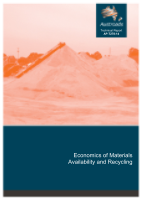Asset Management

- Publication no: AP-T278-14
- ISBN: 978-1-925037-88-3
- Published: 15 October 2014
- PDF (free) Download
The costs of sourcing traditional pavement materials are increasing as sources are being exhausted, haulage distances are increasing, and access to traditional sources is increasingly restricted. As a result, jurisdictions are seeking alternative solutions, one of which is the use of recycled materials.
This report includes details of a two-year survey process which sought information on the use of local and recycled pavement materials by Australian jurisdictions. The survey focused on construction and demolition waste.
The report provides an estimate of the financial cost savings when incorporating recycled aggregates into pavement bases. It also sets out the environmental and social considerations associated with recycling and resource use.
Two detailed case studies examine the experience of a local council in New South Wales and industry in South Australia.
The report suggests there are significant economic and environmental benefits associated with the incorporation of recycled aggregates in pavement bases.
- Summary
- 1. Introduction
- 1.1. Structure of the Report
- 2. Survey Structure and Process
- 2.1. Methodology
- 2.2. Survey Structure in Year 1
- 2.2.1. Survey Participants and Responses
- 2.3. Additional Questions in Year 2
- 2.4. Summary of Results
- 3. Use of Quarried and Recycled Materials and Industry Employment
- 3.1. Current Guidelines
- 3.2. Comparison between Recycled and Quarry Materials
- 3.3. Need for National Uniformity
- 3.3.1. Management of Asbestos
- 3.3.2. Coal Tar Asphalt
- 3.4. Industry Employment
- 3.4.1. National Statistics
- 4. Use of Recycled Materials in Australian States
- 4.1. Overview
- 4.2. New South Wales
- 4.2.1. Current Disposal Costs
- 4.2.2. Number of Significant Recycling Facilities
- 4.2.3. Types of Products and Markets
- 4.2.4. Catchment
- 4.2.5. Product Development
- 4.2.6. Future Demand for Pavement Materials and Sustainability of Quarry Materials
- 4.3. Queensland
- 4.3.1. Materials Processing
- 4.3.2. Regional Areas
- 4.3.3. Products and Markets
- 4.3.4. Barriers and Opportunities
- 4.3.5. Key Findings
- 4.4. Victoria
- 4.4.1. Introduction
- 4.4.2. Annual Volume of C&D Waste Produced and Percentage Recycled
- 4.4.3. Specifications
- 4.4.4. Current Disposal Costs
- 4.4.5. Number of Significant Recycling Facilities
- 4.4.6. Catchment
- 4.4.7. Projects
- 4.4.8. Future Demand for Pavement Materials and Sustainability of Quarry Materials
- 4.5. Western Australia
- 4.5.1. Annual Volume of C&D Waste Produced and Percentage Recycled
- 4.5.2. Number of Significant Recycling Facilities
- 4.5.3. Types of Products and Markets
- 4.5.4. Catchment
- 4.5.5. Product Development
- 4.5.1. Future Demand for Pavement Materials and Sustainability of Quarry Materials
- 4.6. South Australia
- 4.6.1. Current Status
- 4.6.2. Materials Processing
- 4.6.3. Products and Markets
- 4.6.4. Future Demand for Pavement Materials and Sustainability of Quarry Materials
- 4.6.5. Barriers and Opportunities
- 4.6.6. Key Findings
- 4.7. Australian Capital Territory
- 4.7.1. Future Demand for Pavement Materials and Sustainability of Quarry Materials
- 5. Economics of Recycled Aggregates
- 5.1. Environmental and Social Considerations – Recycling and Resource Use
- 5.1.1. Scarcity and Non-renewable Materials
- 5.1.2. Landfill Externalities
- 5.1.3. Low Energy Construction Materials
- 5.2. Market and Pricing Considerations – Recycling and Resource Use
- 5.2.1. Pricing and Availability
- 5.3. Estimated Cost Savings
- 6. Case Study Results
- 6.1. Fairfield Sustainable Resource Centre
- 6.1.1. Production and Consumption of Recycled Road Construction Materials
- 6.1.2. Financial Analysis
- 6.1.3. Summary of Benefits of the SRC
- 6.2. ResourceCo
- 6.2.1. Town of Gawler – Bitumate™
- 6.2.2. St Clair – PM2/20RG Subbase OMC
- 6.2.3. City of Prospect
- 7. Data Gaps and Future Steps
- 8. Conclusions
- References
- Appendix A Information Survey – Austroads Project AT1736 Economics of Materials Availability and Recycling Survey
- A.1 Introduction
- Appendix B Victorian Materials Consumption – Tonnes Per Year
- Appendix C Aspects of the Fairfield City Council Recycling Process
- Appendix D Use of ResourceCo Materials
